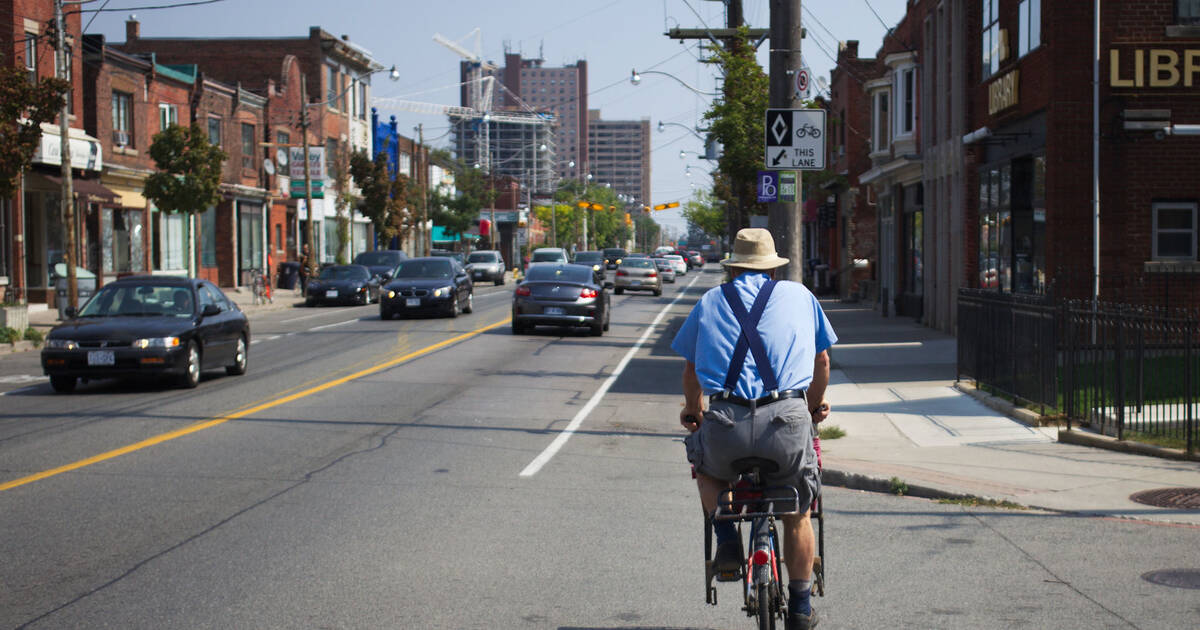
Toronto as a city is hardly overburdened with bike lanes. While we've made some recent strides during the pandemic, our bike lanes are often disjointed and sometimes not particularly safe.
It was just over 40 years ago that Toronto installed its first and immediately controversial bike lanes on Poplar Plains Road south of St. Clair.
Before that, the closest thing to bike lanes were simple looping asphalt trails confined entirely to public parks, ideal for weekend riding with the kids but not so useful for getting to work.
Convincing motorists pre-occupied with the rapidly choking traffic to accept space for a new mode of transport wasn't, and still isn't, easy.
Metro Toronto's first Parks Commissioner Tommy Thompson was, undoubtedly, a champion of the city's recreational spaces.
His famous "please walk on the grass" signs that once dotted Toronto's verdant public lawns encapsulated his ethos that open spaces were at their best when visitors were free to wander off the path.
Under Thompson, the city built shared cycle tracks in Ashbridges Bay Park, the Toronto Islands, High Park, and many other public gardens.
In 1972 the only path exclusively for the use of bicycles ran for 2.4 kms just north of the boardwalk in the Beach from the foot of Fernwood Park Avenue to Woodbine Park. It's still there, a piece of the much larger Martin Goodman Waterfront trail.
That summer the Toronto Star proclaimed the "Year of the Bike" with a full-page photo of a cheerful Tommy Thompson perched on a saddle surrounded by kids.
Reporter Roger Whittaker and his 10-speed Schwinn mapped out a 100-mile route round the city from the Beaches track to High Park, up to Steeles, dropping down to Sheppard, through the ravine system out to Scarborough, and back.
At no point did Whittaker have his own lane, painted or otherwise.
It would take seven years for Toronto to get its first marked bike lane, a fury-inducing strip inexplicably located on a residential road south of St. Clair.
Immediately drivers fumed about the road's reduction to one lane and cyclists "shooting down it two and three at a time" against traffic toward Davenport Road. "[Mayor] Sewell and his gang got us again," complained one driver to the Toronto Star.
The angry drivers might have had a point, the lane was poorly located on a steep hill that cyclists often had to dismount and walk up.
In addition, the markings were only on the east side of the street so bikers wanting, naturally, to sweep down the hill had to share a lane as narrow as four feet with oncoming riders, if there actually were any.
No-one really used the bike lane, largely, I suspect, because of its horrible location. A report cited in news reports at the time said 847 cars used the road during rush-hour while just three bikers puffed up the winding hill. It wasn't good PR for Toronto's fledgling biking community.
An editorial published a few months after the Poplar Plains lane was opened warned with solemn dismay that bike lanes were "an ill-conceived notion that will only exacerbate already intolerable traffic jams."
Under the headline "There's a limit to bicycle lanes," the piece fretted that further expansion of the cycling project to Wellesley and Harbord streets — a route that's getting its own entirely separated lanes in the new year — would fatally cut space for cars from four lanes to two and choke the city.
The arguments against dedicated lanes were the same then as they are today: cold winters would drive cyclists off the street; after a week or turning up "sweaty and disheveled" at work, office workers would lose ditch their 10-speed; roads would become a dangerous obstacle course of pedestrians, bikers, and cars.
But that didn't happen. The newly-formed City Cycling Committee spent the 1980s developing the ring and post lock, installing tire-friendly drain covers, and establishing the Martin Goodman Waterfront trail for cyclists.
Piece by piece, new on-street bike lanes were added to the network. A second bike lane opened on Wellesley on June 2. 1979.
Despite an occasionally ominous outlook and relatively low turnout in rush hour — apparently just 127 cyclists entered the downtown during a typical rush hour in 1979 — getting to work under one's own steam steadily increased in popularity.
Today the cycling network map shows progress but there's still a long way to go to making Toronto the bike-friendly city it can be.
by Chris Bateman via blogTO

No comments:
Post a Comment